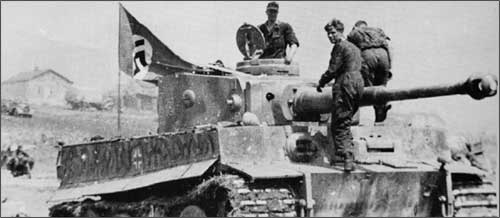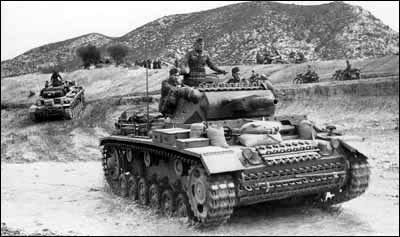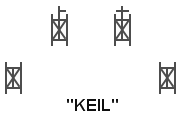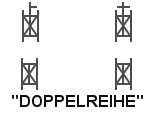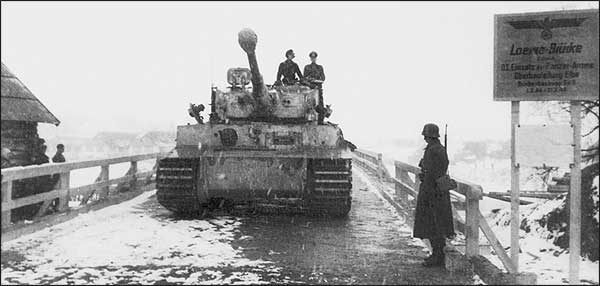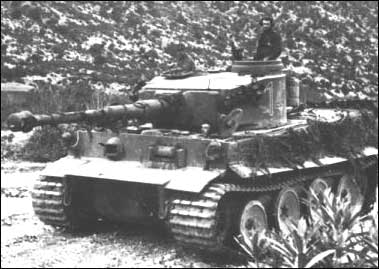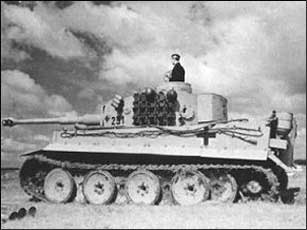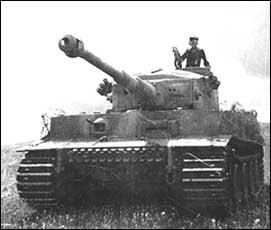|
Introduction The introduction of the Panzerkampfwagen Tiger Ausf.E heavy tank provided a dramatic improvement in the power of German armored formations. Both because of the real technical advantages of the Tiger I, and the propaganda advantages of creating "elite" units in the Panzertruppen, the Tiger was assigned to special heavy tank battalions (schwere Panzer Abteilungen - sPzAbt). These were to be held at army or corps level and assigned as needed to reinforce other units during a campaign. Only a few divisions ever received organic Tiger battalions. These included Panzergrenadier Division Großdeutschland and Panzer Lehr Division. In 1937, General Heinz Guderian, in "Achtung Panzer!" detailed the tactics and concepts of the employment and use of tanks in a future war. establishing the principles of concentration applicable to all tanks regardless of size or mission. He stated that "concentration of the available armored forces will always be more effective than dispersing them, irrespective of whether talking about a defensive or offensive posture, a breakthrough or an envelopment; a pursuit or a counterattack". (Source: WILBECK, Christopher W., Sledgehammers: Strengths and Flaws of Tiger Heavy Tank Battalions in World War II.) When discussing heavy tanks, Guderian was prophetic in writing that "there will never be many heavy tanks, and they will be used either independently or within the structure of the tank forces, according to the mission. They represent an extremely dangerous threat and are not to be underestimated" (WILBECK, Christopher W., op cit). Prior to the Tiger's introduction, and lacking a true heavy tank, the Germans used the PzKpfw IV with a low velocity 75 mm main gun to fulfill the heavy tank role within the medium tank companies though Poland, France, and during Operation Barbarossa in June 1941. Until the German armored forces encountered Soviet heavy tanks, such as the KV I, KV II, and the T-34/76, the PzKpfw IV was sufficiently well armored and armed to meet the tactical demands of a heavy tank. The appearance of the T-34/76, specifically, greatly influenced and decisively accelerated German heavy tank development. The German Army needed a heavy tank with more armor and a larger main gun capable of penetrating the sloped armor of the T-34 (WILBECK, Christopher W., op cit). The Panzerkampfwagen Tiger Ausf.E was the weapons system developed to meet those and future threats on the battlefield, and the schwere Panzer Abteilungen the organization that took form to meet these requirements. Origins of the Schwere Panzer Abteilungen.
As originally conceived, the schwere Panzer-Kompanien (heavy tank companies) were organized as three Zuege (platoons) each with three Pz.Kpfw.Tiger Ausf.E for a total of nine heavy tanks. Later the organization was expanded to include 10 Pz.Kpfw.III along with the 9 Tigers to compose one schwere Panzer-Kompanie. The first three units send into the field (schwere Panzer-Abteilung 501, 502, and 503) experimented with practically every possible combination of Pz.Kpfw.III and Tigers within their schwere Panzer-Kompanien. 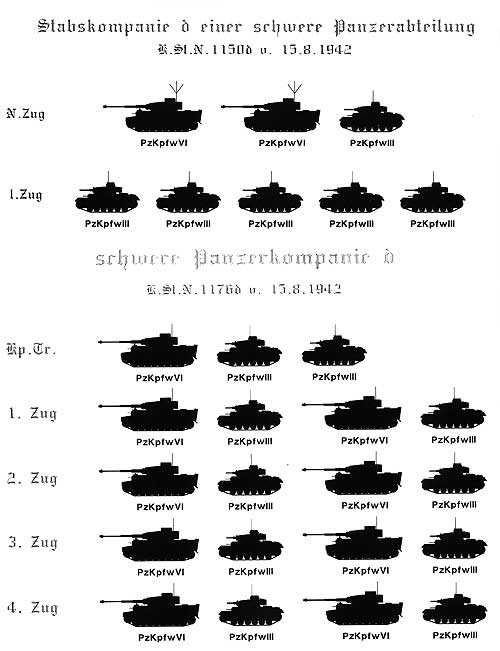 First TOE for a Tiger Company (1942-1943). Only after the first combat reports were received from the unit commanders was the decision made to increase the strength of each company to 14 Pz.Kpfw.Tiger Ausf.E and to drop all the Pz.Kpfw.III.
Many of the unit commanders had argued for the retention of the Pz.Kpfw.III, to perform the many duties for which the Tiger was not suited to, but their requests went unheeded and the Pz.Kpfw.III were replaced by Sd.Kfz.250, assigned to the Abteilung-Stabskompanie (battalion headquarters company) for performing scouting, reconnaissance, running messages, standing perimeter guard, and other tasks not suitable for Tigers. This organization of 14 Tigers per schwere Panzer-Kompanie was retained to the end of the war. At first there were only two units, schwere Panzer-Kompanie 501 and 502. created as Heerestruppen (independent army units). These were incorporated into schwere Panzer-Abteilung 501, and two more units each with two companies were created, schwere Panzer-Abteilung 502 (heavy tank battalion) and 503. Then the idea was tested of incorporating the heavy tanks into Panzer-Regiments. This phase saw the creation of a schwere Panzer-Kompanie for Panzer Regiment Großdeutschland and three SS-Panzer-Regiments as well as the assignment of several of the schwere Panzer-Abteilungen as the III.Abteilung within existing Panzer Regiments. However, this concept was short-lived. Under Guderian's guidance, all newly created schwere Panzer-Abteilungen, as well as all already in service, were converted to pure units with 45 Tigers.This organization with three Tigers for the Abteilung-Stab and 14 Tigers in each of the three schwere Panzer-Kompanien lasted through the end of the war. 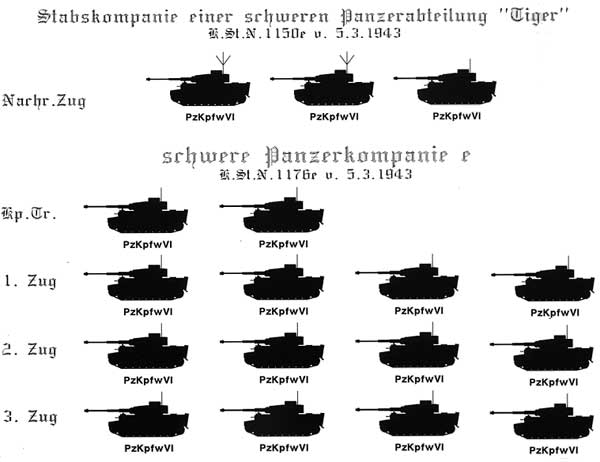 The Definitive TOE for a Tiger Company (1943-1945). Altogether, eleven schwere Panzer-Abteilungen were created for the Heer (initially numbered 501 through 510 and the III.Abteilung/Panzer-Regiment Großdeutschland), and three for the SS (numbered 101 through 103 in October 1943). In addition, three Panzer-Kompanien (FKL) and Panzer-Abteilung (FKL) 301 were converted to Tigers as control vehicles for deploying the Sprengstofftraeger (Sd.Kfz.301) (radio-controlled explosive charge carriers). As the situation deteriorated, ad hoc units were formed and quickly thrown into combat as stop gap measures. These ad hoc units included schwere Panzer Regiment Bäke, Tigergruppe Meyer and Panzer-Kompanie Hummel as well as other last-gasp attempts to activate training and experimental units with their few operational Tigers at the end of the war. |
Tiger Tactics
The first heavy tank companies were committed to battle on an ad hoc basis, as vehicles became available, therefore achieving little but giving away the precious element of surprise that an impenetrable shroud of secrecy had given them. The result was something of a fiasco. Certainly, at that time, very little thought or guidance had been given to developing tactics. As a result the men of the first units - 501st, 502nd, and 503rd schwere Panzer Abteilungen - were left largely to their own devices, with only the experience gained earlier in light and medium tank units to guide them. Not unnaturally, the development of tactics were a priority, and regular reports were demanded of the unit commanders. There were four formations authorized for the Tiger platoon. Line abreast (Linie), with the Platoon Leader (Zuegfuherer) on the extreme right and the Section Leader two vehicles away, was used for assembly. Row (Reihe), with the Platoon Leader at the head and the Section Leader in the third vehicle, was used both for assembly and marching, the former with 10m (33ft) between vehicles, the latter at 25 m (84 ft) intervals. Double row (Doppelreihe), which for a platoon was actually a box formation, was used for approach marches, over open country, and in the attack, with the Platoon Leader at the head of the right hand row and the Section Leader alongside him. In combat, the rows were to be 150 m (165 yds) apart and the lines 100 m (110 yds). The wedge (Keil), was the most often used attack formation, with the Platoon Leader and the Section Leader level and separated by 100 m (110 yds), and the second tank in each section 100 m (110 yds) behind and the same distance to right and left, respectively. Therefore, when combat started, the Platoon Leader was to move to a position within the formation from were he could make the best use possible of both terrain and situation, the chances of either double row or wedge staying intact for very long seemed slight. Tiger Platoon Authorized Formations
There were five authorized formations for the Tiger company. The column (Kolonne), used for assembly, was essentially three platoon rows side by side, with the company Commander and his alternate vehicle at the head of the center row. For marches an extended row was adopted. The Company Commander took the the lead, followed by the second Kompanie Truppe vehicle, with the three platoons strung out behind. For approach marches a company double row was adopted, with the third platoon alongside the first. The company wedge was essentially a wedge of wedges, with the company headquarters vehicles in the center of the formation, in echelon behind the rearmost tanks of the first platoon and ahead of the lead tanks of the second and third platoons; as an alternative, the second and third platoons could form a row or double row behind the company headquarters vehicles. The broad wedge (Breitkeil), was the company wedge in reverse, with two platoons up and one back, and the company headquarters vehicles in the center of the formation, in echelon ahead of the two lead tanks of the third platoon. Where the company found itself on an open flank, the third platoon would deploy in an echelon to the open side. In either company wedge or broad wedge formation, the company occupied an area of some 700m (765 yds) across and 400m (440 yds) deep. Where Tigers operated independently, with less capable medium tanks in support, the wedge formation was favoured, with a single heavy tank at its point and medium tanks (and later Pz.Kpfw.Panthers) making the tail. This was modified as early as July 1943, into a "bell". This was essentially a right arc or rounded wedge of medium tanks with a Tiger in its center, where a bell would have its clapper. Evidently, the tactical directives were modified in light of experience, and particularly when it became clear that far from being 'especially suitable for pursuit', the Tiger was actually at its best in an ambush position, picking off incoming enemy tanks at long range with its superior gun. Camouflage and Markings of the Tiger Battalions 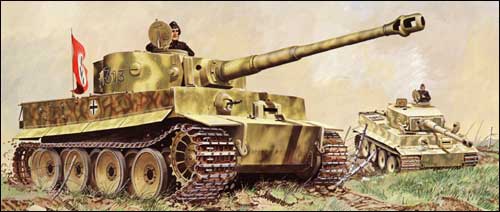 Because they served on many fronts, attached to a variety of other units, and in large multi-unit formations, Tiger battalions used more distinctive tactical markings, and carried a greater variety of these markings than most other German tank units. The first Tigers issued to front line units during mid-1942 were delivered in overall Dark Grey (RAL 7027). In the Winter of 1942-43, washable White paint was used as camouflage in snow-covered areas. The Tigers of sPzAbt.501 , which deployed to Africa during late 1942, were camouflaged in Desert Brown (RAL 8020) and while Dark Gray was authorized to be used as a second color in a disruptive camouflage pattern, there is no evidence that sPzAbt.501 ever painted their vehicles in this manner. In the more temperate climate of coastal Tunisia, many of the tanks of sPzAbt.501 were oversprayed with Olive Green (RAL 7008) to enhance their camouflage. Tigers of sPzAbt.504 were camouflaged in overall Brown (RAL 8020) oversprayed with Olive Green (RAL 7008). It is not known if any Tigers went to North Africa painted in Dark Yellow (also known as Wehrmacht Olive), which was specified for use as an overall basecoat on all combat and front line support vehicles during 1943. The camouflage colors used to paint vehicles, with a wide variety of disruptive patterns, were Olive Green (RAL 7008 - the light-green color first ordered for use in North Africa in 1941) and Red Brown (RAL 8017) - which was more of a brown than a red). Tigers used all these colors in a wide variety of schemes and applications. During August of 1944, to reflect the needs of a changing war situation, the Germans added new camouflage colors which were intended to be used in place of the older shades. A new Olive Green (RAL 6003) was introduced, along with a new Red Brown (RAL 8012). The new Red Brown was more red than the older Red Brown, while the new Olive Green was somewhat darker than RAL 7008, and was often used as a primer color on many vehicles in November of 1944. In the last months of the war, Dark Gray was also used on a number of vehicles, both as a primer and as a camouflage color. It should be noted that older paints were almost always used until supplies were exhausted, so many older vehicles carried new paint colors while newer vehicles often appeared in older colors. It should be noted that many German manufacturers used Red Oxide primers extensively, and some of these primer paints appeared on new vehicles. The markings used on Tigers were perhaps more varied than those of any other German combat vehicle. As the Tiger battalions moved from engagement to engagement, from one command structure to another, they came under the command of many different formations. This led, in many cases, to the Tiger units adopting different markings and even marking systems, especially in the tank identification numbers. Most Tiger units used the standard Wehrmacht three-digit system of vehicle identification, the first digit denoting the company, the second denoted the platoon, and the third digit denoted the individual vehicle within the platoon. In some Tiger battalions, only the company number was used to identify the vehicle, in others, only the platoon and individual vehicle number, while other units used only the vehicle number. In addition, a wide variety of number styles and colors were found in Tiger units. Many Tiger battalions used fairly consistent numbering, others changed not only styles, but also systems. Some of these resulted from being attached to another unit, and as a result having to renumber the Tigers. In other cases, these changes appear to have resulted from changes in commanding officers, a new CO changing things to suit his own preferences. 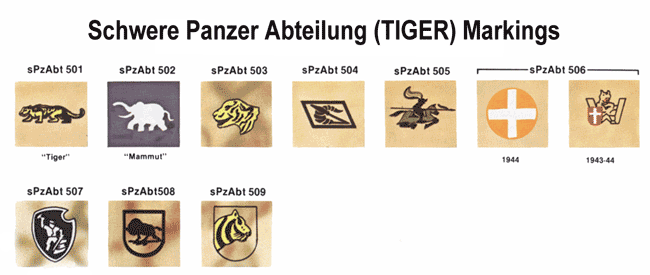 |
Some data about the individual Tiger tank heavy battalions. 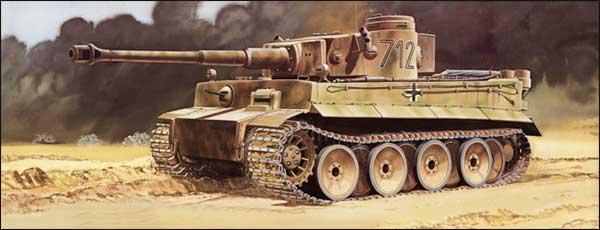 A Tiger I of sPzAbt.501, North Africa, 1943. Schwere Panzer Abteilung 501 - sPzAbt. 501
Following the Allied landings in northwest Africa, Germany quickly sent troops to Tunisia to block access to Lybia and deprive the Allies of bases within easy striking distance of Italy. One of those units was the schwere Panzer Abteilung 501, which was one of the two Tiger units that had been promised to Rommel and prepared for tropical deployment. Originally, sPzAbt 501 was to have been outfitted with the Porsche-Tigers, but due to the delays and subsequent cancellation of Porsche-Tiger production, the sPzAbt 501 was issued normal Henschel-Tigers.
The 501st had been outfitted with 20 Tigers and 25 PzKpfw III Ausf N. All 20 Tigers safely made the crossing to Tunisia, the first three Tigers of 1. Kompanie being unloaded at Bizerta on 23 November 1942. The last two Tigers did not arrive until 24 January 1943, the second kompanie being diverted due to the occupation of southern France and therefore delayed in reaching Tunisia. The sPzAbt 501 surrendered in Tunisia, on 12 May 1943 but was reformed from the surviving remnants in September and received 45 Tigers from the ordnance depot in October and November. Sent to the Eastern Front in November, sPzAbt 501 did not receive any new production replacements until six Tigers were sent in June 1944. Decimated by the Russian summer offensive, sPzAbt 501 was pulled out in early July 1944, reformed and refitted with the Tiger II.  The famous schwere Panzer Abeilung 501"Crouching Tiger" marking. Issued 45 Tiger II, the 501st was ordered to join Heeres Gruppe Nordukraine (army group) on 6 August. The 501st was overwhelmed during the Russian winter offensive and ordered to be disbanded and used to create the sPzJgAbt 512 by orders dated 11 February 1945. Schwere Panzer Abteilung 502 - sPzAbt. 502 On 23 July 1942, Hitler had ordered
the first company of Tigers to be formed quickly and sent to the
front at Leningrad. The first unit to receive Henschel-Tigers was
the 1. Kompanie of schwere Panzer Abteilung 502, four arriving
on August 19 and 20. These Tigers, accompanied by four Pz.Kpfw.III
Ausf.N, arrived at the front and went into combat on 29 August
1942. Two of the four Tigers were still operational at the end
of the day and the other two were recovered and repaired. The rest of the company arrived at the front on 25 November 1942 with five Tigers, nine Pz.Kpfw.IIIs (50mm KwK L/60), and five Pz.Kpfw.III Ausf.N. Seven more Tigers arrived at the front in February 1943 to replace losses. Ordered to upgrade to the new organization, the 1.Kompanie received seven more Tigers in June 1943, to fill their complement of 14 Tigers.
Having been outfitted in December
with nine Tigers and ten Pz.Kpfw.III Ausf.N, the 2.Kompanie was
attached to the sPzAbt 503 and on 10 February 1943, the 2.Kompanie
of the 502nd was renamed 3.Kompanie/sPzAbt 503 and became
a permanent part of the 503rd. The 502nd was renamed as schwere Panzer Abteilung 511 on 5 January 1945. The last 13 Tiger IIs produced by Henschel were picked up directly from the factory on 31 March 1945, by the crews of the 3.Kompanie/Tiger Abt. 510 and 3.Kompanie/Tiger Abt. 511. On 31 March, they reported that each company possessed eight Tiger IIs. Of these 12 were brand new productions from Henschel along with three older Tiger IIs from the Waffenamt at Senneläger and one older Tiger II from the Waffenamt at Northeim. On 1 April 1945, they engaged in combat with seven Tigers per company in Kassel, reporting that three further Tiger IIs had been lost due to bomb damage. The battalion continued the struggle on the Eastern Front until the end of the War. |
||||||||
The ARMOR Site! is © Copyright 1997-2008 Fabio Prado . All Rights Reserved. |


